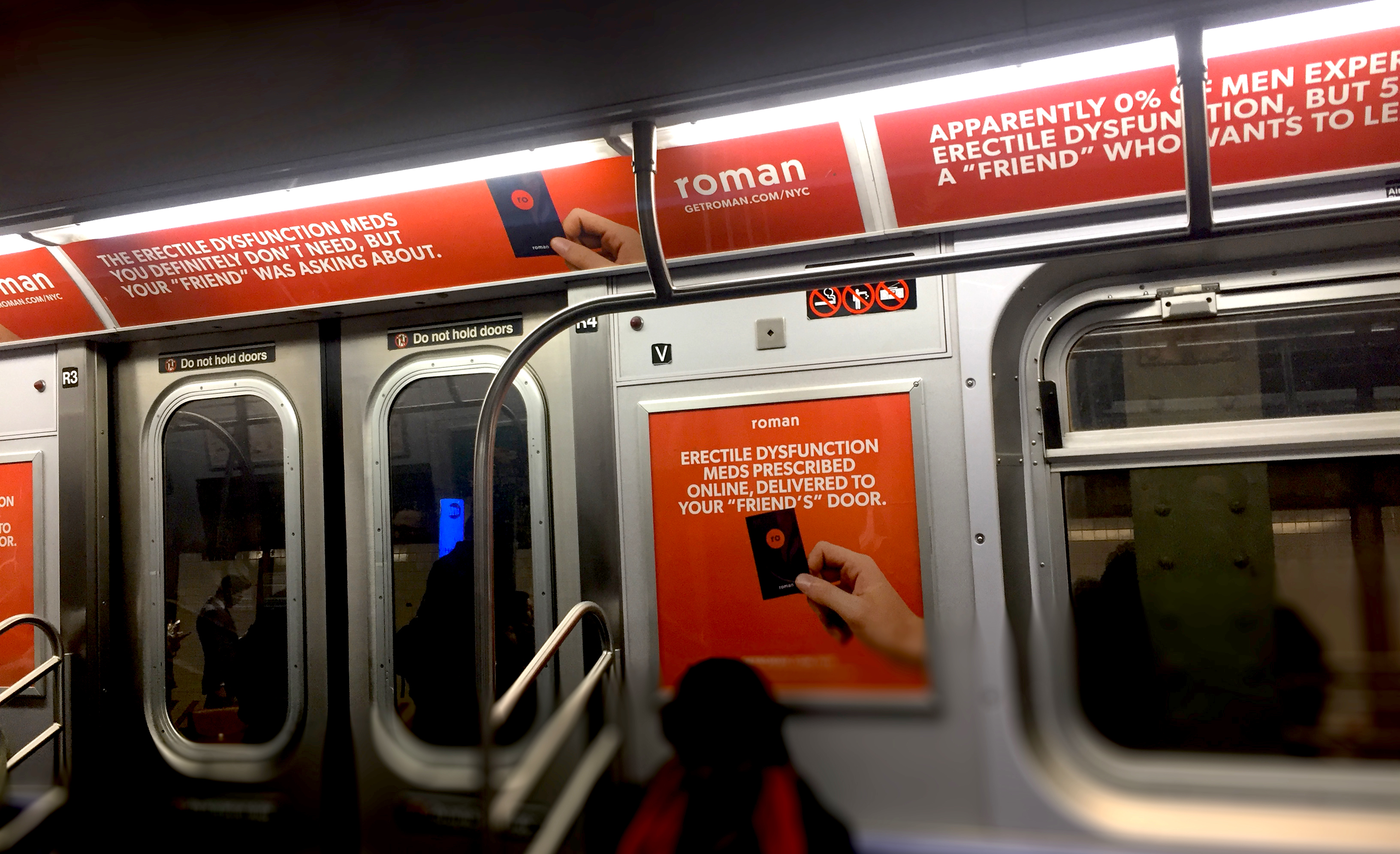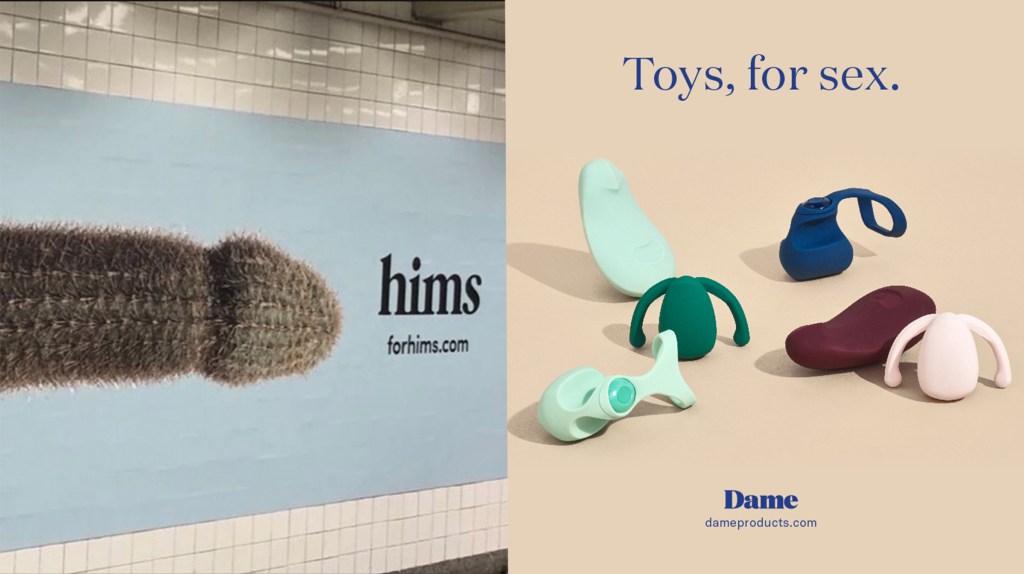On the subway in New York earlier this year, I noticed advertisements for two erectile dysfunction medication brands, Roman and Hims. I’d never seen, or at least never noticed, subway ads for ED before, but the tongue-in-cheek slogans and minimalist designs these brands used caught my eye. Hims’s ads used eggplants and limp or hard cacti as visual metaphors for penises. Roman’s were more direct: “Erectile dysfunction meds you definitely don’t need, but your ‘friend’ was asking about,” reads one, in all caps. I was intrigued for a number of reasons: erections aren’t generally brought to my attention on the subway (thankfully), and the ads seemed to be targeting millennials (not your typical ED ad market, I thought). Most strikingly, they reminded me of the Thinx subway ad controversy that was all the rage in the literal New York underground nearly three years ago.
In 2015, the “period-proof” underwear brand Thinx turned in an advertisement proposal to Outfront Media, the third-party agency responsible for the ads in the New York subway system. The proposed posters featured egg yolks suspended in albumen or dripping off of a table, halved grapefruits, and women in basic shirts and underwear in front of minimalist pink backgrounds, all beside the phrase, “For women with periods.” The grapefruits and eggs signified vulvas and menstrual blood, respectively.
Videos by VICE
When Thinx showed their ads to Outfront, the agency told them the posters were “inappropriate.” “It was not acceptable to them that we used the word ‘period’,” Thinx’s CBO, Siobhan Lonergan, tells Broadly. (An Outfront rep was allegedly concerned that a child might see the ad and ask their parents about what a period is.) According to Mic, Outfront also said the ads had “a bit too much skin.” When Thinx questioned Outfront’s stance, a rep allegedly told Thinx’s director of marketing at the time, Veronica del Rosario, “This is not a women’s issue. Don’t try to make it a women’s rights thing.”

Thinx went to the press with Outfront’s reaction, which Lonergan says was blatantly sexist. The media frenzy that followed agreed, and the MTA soon told the New York Times that “of course” they would approve Thinx’s initial ads—grapefruits, eggs, and all.
The visual cues of those Thinx ads were essentially the precursors to the cacti-and-eggplant “penises” in the Hims ads, and Thinx’s tone was conversational and young, like Roman’s is now. I was curious: If Roman or Hims had a hard time getting Outfront to approve words like “erectile” or visual penis stand-ins, the news hadn’t made its way to the media. Given that the companies, unlike Thinx, advertised a product directly related to sex, I wondered if they’d faced the kind of scrutiny Thinx did.
“Given the topic, we expected to work closely with different groups (Outfront, medical advisors, etc.) to ensure a successful campaign. We had a great and open dialogue throughout the process,” the CEO and cofounder of Roman, Zachariah Reitano, tells Broadly.
“Their professionalism, and the speed with which everyone understood and embraced the importance of breaking down the stigma of ED, was incredible.”
Andrew Dudum, the founder and CEO of Hims, recounts a similarly positive experience with Outfront. “They understood our mission to destigmatize these issues and normalize conversations surrounding men’s wellness that have historically been considered taboo,” he tells Broadly over email. “[We] were able to execute in a way that was on brand and appropriate, given the larger audience and the MTA’s parameters.”

While Reitano and Dudum describe working with the MTA’s ad agencies as a process of “understanding” and “professionalism,” Lonergan recalls it as “frustrating and offensive.” When Broadly reached out to Outfront Media to ask whether the company’s views and/or policies had evolved since 2015, a rep initially agreed to answer our questions, only to follow up days later, saying no comment was available.
The MTA’s advertising policy states that they do not accept advertising that “depicts or describes in a patently offensive manner sexual or excretory activities” or “contains sexually explicit material that appeals to the prurient interest in sex.” The MTA’s history of approving ads that objectify and body-shame women suggests an arbitrary interpretation of their guidelines. Breast augmentation ads have been a staple in NYC subway advertising long before Thinx. Ironically, one of the most famous also uses fruit to double for body parts.
For More Stories Like This, Sign-Up for Our Newsletter
When asked if Roman was at all inspired by Thinx, Reitano says, “Absolutely. Thinx is a bold and empowering brand breaking down a taboo topic. They were the first and have inspired many brands’ advertisements across a variety of channels.”
Lonergan says Thinx harbors no hard feelings in regards to the erectile dysfunction ads. She’s happy for Roman and Hims and believes Thinx helped lay the groundwork for public advertising around taboo subjects, gendered or otherwise. “When it comes to bodily functions, we believe as long as the ads are respectful, they should have a platform,” she says. “Our experience with the MTA has paved the way for more brands to do this.”
Outfront and the MTA may have come around to allowing advertisements that deal with bodily functions (even ones that have to do with vaginas) and the sexual pleasure and health of people with penises. Their next challenge is depicting others’ sexual health and pleasure. Earlier this year, Outfront rejected subtle ads from Unbound, a women’s sexual health company. After Fast Company reported the story, Outfront reached out to Unbound “to start the conversation about re-submitting to the MTA.” In the meantime, New Yorkers can enjoy subway ads depicting the Museum of Sex, breast implants, and erections.




